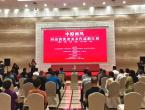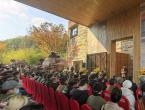Artistic rural construction addresses the issue of hollow villages
-- The revitalization practice of Jiande Changling Art Village
■ Liu Jing (Hangzhou Normal University) Lang Dong (Jiande Social Science Circle Federation)
The Dilemma of Hollow Villages: An Opportunity for Artistic Rural Construction
As China's urbanization rate steadily increases, rural hollowing-out has become a bottleneck restricting coordinated urban-rural development. Hollowing-out is not a single phenomenon of population loss, but a multidimensional and complex dilemma. Population hollowing-out is the core. The derived issues of industrial and economic hollowing-out, residential environment hollowing-out, service facility hollowing-out, and cultural and ecological hollowing-out lead to weakened local cultural identity and a risk of fracture in the spiritual core of rural areas. From a national strategic perspective, the spread of hollow villages restricts the promotion of common prosperity and delays the process of socialist modernization.
Artistic rural construction, as an emerging rural development model, provides a precise solution to the dilemma of hollow villages. It utilizes artistic creativity as a medium to establish a bidirectional mechanism where "art empowers the countryside and the countryside nourishes art," systematically enhancing the spatial environment, industrial development, and cultural inheritance. Through "flexible renewal," artistic rural construction revitalizes idle resources, promoting the transformation of "hollow villages" into "art villages." It breaks through the limitations of traditional construction, fully integrates art into rural development, awakens the local cultural identity of the people, and reshapes rural cultural confidence. At the same time, it attracts artists, creative talents, and tourists to participate, injecting creative momentum, promoting diversified industrial development, increasing employment, attracting population return, and ultimately contributing to the comprehensive revitalization of rural areas.
The practice of artistic rural construction in Changling Art Village
Changling Village is a high-altitude natural village under the jurisdiction of Shiling Village, Genglou Street, Jiande City. Located at an altitude of over 300 meters, it is 10 kilometers away from the main urban area of Jiande and 4 kilometers from the market town of Genglou Street, enjoying a superior geographical location. Surrounded by mountains, the village boasts a forest coverage rate of over 80% and high negative oxygen ion content, making it a natural "green oxygen bar". The terraces surrounding the village are layered, and the lake at the entrance ripples with clear waters, providing a broad view of Xin'an River and the urban area of Jiande. The natural landscape is uniquely blessed. However, due to the impact of downhill migration and migrant workers, there are more than 30 vacant agricultural and residential buildings in the village, with a current permanent population of only more than 40 people, mainly elderly people, making it a typical "hollow village". Since 2019, Jiande City has leveraged its superior environmental and geographical advantages to build an art village, revitalize vacant spaces, introduce artistic talents, and transform the "hollow village" into a demonstration village for artistic rural construction.
1. Strengthen the foundation through Party building and networking, and prioritize policies to promote the arts
With the core of joint party building, Genglou Street in Jiande City has anchored the main development line of "art revitalization" and established a dual-driven support system of policy and infrastructure. At the policy level, it has taken the lead in formulating the "Changling Art Village Development Plan", clarifying the positioning of art rural construction, and simultaneously introducing supporting policies such as government financial support, social capital introduction, and special training for artists. At the infrastructure level, it has focused on tackling hardware shortcomings, completed road hardening projects, upgraded water and electricity networks, and achieved full coverage of 5G communication networks to meet the needs of remote digital creation and online promotion.
On this basis, the street launched the "Continuing the 'Cooperative' Red Gene - Cooperation for Common Prosperity · Joint Construction and Common Prosperity Action in Changling Art Village Area", successfully establishing a development pattern of "art empowerment on the mountain and common prosperity in the fields below" through party building as a link.
2. Space redesign breaks barriers, revitalizing idle resources
Addressing the issues of fragmented urban and rural spatial functions and low utilization of idle resources, Changling Village has innovated a collaborative model that integrates government coordination with social introduction, achieving spatial value reconstruction through three major paths. Firstly, the abandoned old tea factory has been transformed into the "Changling Mountain Art Space", retaining the original architectural structure and internally dividing it into art exhibition areas, cultural exchange areas, and themed activity areas. Hundreds of events have been organized, transforming the old building into a new landmark of rural culture. Secondly, personalized renovations have been carried out on idle agricultural and residential spaces, creating artist studios and themed guesthouses, thus upgrading the space for artistic creation and residency. Thirdly, over 160 acres of idle land have been revitalized, with the construction of Chinese herbal medicine terraces and the planting of Bletilla striata, which possesses both medicinal and ornamental value. Through the reshaping of spatial functions, the village is no longer limited to traditional agricultural attributes, but also incorporates city-level functions such as creation, residence, leisure, and cultural innovation, promoting the integration of urban and rural spatial functions.
3. Talent agglomeration stimulates vitality, and art empowers beautiful villages
Changling Village relies on mechanisms such as "Cultural Special Representatives" and "Literary Village Leaders" to build a talent team and coordinate grassroots cultural service mechanisms. Bao Yifei, a member of the Zhejiang Provincial Artists Association, was among the first batch of artists to settle in and took the lead in renting a villager's courtyard to convert into a studio. He not only participated deeply in the planning and design of the art village, but also took the initiative to organize multiple "Art Village" themed promotional events and invited professional institutions such as the Xiling Seal Society and Hangzhou Cultural Tourism Association to conduct fieldwork and creation. Under his leadership, more than ten high-quality art projects, including Tang Liguang's Guqin Studio and Ye Huafeng's Ceramic Art Museum, have been successively established. The "Cultural Special Representatives" and "Literary Village Leaders" teams carry out social aesthetic education through literary and artistic volunteer services, drive local villagers to engage in literary and artistic activities, and cultivate rural literary and artistic talents. This is not only a specific practice of delivering high-quality cultural resources directly to the grassroots, but also creates a favorable cultural environment for literary and artistic activities and creation.
4. Industrial integration promotes common prosperity, and multi-party cooperation strengthens momentum
Changling Village has established a multi-party cooperation system featuring government guidance, artist creation, enterprise operation, and villager participation, promoting the deep integration of multiple industries such as art, agriculture, cultural tourism, and education. Firstly, "Art + Research and Learning" involves collaborating with schools and training institutions to develop art courses such as painting and sketching, and handicraft making. Secondly, "Art + Agriculture" leverages the terraced fields of Chinese herbal medicine and lake water resources to develop sightseeing agriculture, launching special projects such as farming experiences, creating distinctive brands, and significantly increasing the added value of agricultural products. Thirdly, "Art + Cultural Tourism" involves designing art-themed guesthouses to attract art creators, giving priority to hiring villagers as housekeepers and other positions, thereby increasing employment opportunities. Industrial integration not only activates the rural economy but also allows villagers to deeply participate in the process of artistic rural construction, achieving the goal of "prosperous industries, wealthy villagers, and beautiful villages".
Challenges and Strategies of Artistic Rural Construction
The construction of Changling Village Art Township has achieved remarkable results, but its long-term development faces multiple challenges, necessitating the exploration of breakthrough strategies.
1. Funding Shortage: From "Relying on the Government" to "Diversified Self-Sustaining Capabilities". Government funding primarily focuses on infrastructure and planning design. It is necessary to deepen the cooperation between "the government and social capital", open up mechanisms for co-creation, co-construction, and sharing, and overcome the limitations of single input.
2. Talent Retention: From "Short-term Attraction" to "Long-term Rooting". Leverage artists to attract art communities to settle in; target "art nomads" in the digital age and attract young art talents to take root through online platforms; collaborate with universities to establish practice bases; engage local villagers in special training, integrate digital art skills teaching, and cultivate a local team for the era.
3. Cultural Integration: From "External Implantation" to "Local Coexistence". Open art experiences attract villagers to participate, deeply explore local folklore and intangible cultural heritage, and guide external artists to create works incorporating digital technology. Establish workshops for intangible cultural heritage, organize folklore activities, and disseminate local culture through new media such as short videos and live broadcasts, strengthening villagers' identity and achieving cultural integration.
Looking ahead, rural art construction holds vast prospects within the rural revitalization strategy. With people's aspiration for a better life and their increasing emphasis on rural culture, rural art construction, bolstered by digital art technology, will embrace even more development opportunities.
Copyright Notice: Original content on this website is welcome to be reposted. Please indicate the source when reposting, Global Art Network www.caanets.com; Some of the content posted on this website comes from the internet. If there is any infringement, please contact this website to delete it.




